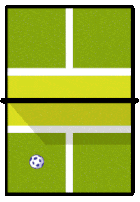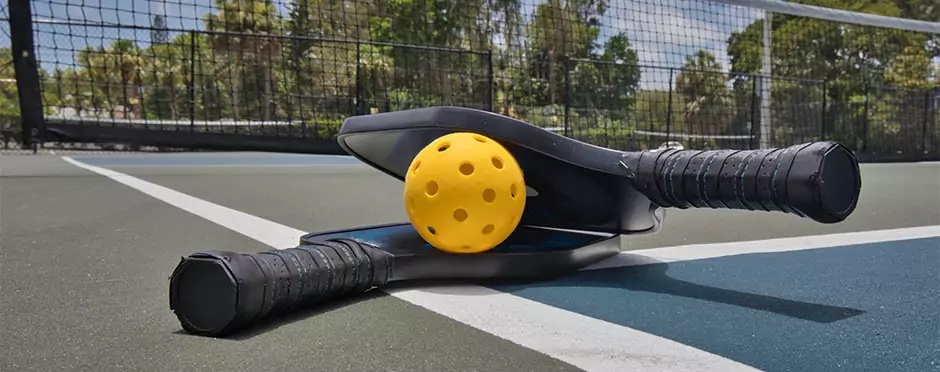by Tara Hackney, PT, DPT, OCS, KTTP
Even though pickleball was invented in 1965, it has been gaining popularity very quickly since the early 2000s. Pickleball was the fastest-growing sport from 2019-2022. Pickleball is played both indoors and outdoors and has both singles and doubles. Though it resembles tennis, pickleball is played on a much smaller court and using solid-faced paddles and the rules differ from tennis as well. As with any sport, as the popularity grows, so do the injuries. Here are some of the injuries that can occur in pickleball and ways to prevent injury:
Achilles tendinitis or tear
The Achilles tendon is the large tendon at the back of the ankle. It connects the two main calf muscles, the Gastrocnemius and the Soleus, to the heel bone. Injury can occur at the attachment to the heel, the middle of the tendon, or the calf muscles. Pickleball can increase your risk of Achilles injury due to repetitive movements and sudden starts and stops. Over time, it is thought that Achilles tendinitis leads to changes in the normal fiber arrangement of the tendon. Due to these changes, thickening can occur, and the area can become less flexible. This, in turn, leads to weakness of the tissue, which can lead to an increased risk of Achilles tendon rupture.
Symptoms of Achilles tendinitis include:
- Pain over the calf or heel
- Swelling over the Achilles tendon
- Stiffness in the ankle or calf
- Pain with quick movements or hopping
Treatment includes rest, ice, stretching, massage, and strengthening the area. Prevention of Achilles injuries focuses on stretching before and after activity as well as strengthening the area.
Elbow tendinitis (“tennis elbow”)
Lateral epicondylitis is more commonly known as tennis elbow. It is a pain over the outside portion of the elbow and can extend into the forearm. It is considered a form of tendinitis which means it is due to repetitive motions and not a one-time event.
Symptoms of tennis elbow can include:
- Pain over the elbow,
- Pain with gripping and extending the wrist,
- Feeling weak in your grip, pain with elbow or wrist movement,
- Swelling,
- Pain with twisting such as opening a door or jar.
Treatment includes ice, rest, stretching, possible use of a brace and a splint, and strengthening for wrist, elbow, and shoulder muscles.
Shoulder Injuries
Reaching overhead to play racket sports requires a lot of force generated by the rotator cuff muscles. Due to the repetitive nature of pickleball with sweeping and slicing motions, shoulder injuries can occur, including rotator cuff tendinitis. Rotator cuff injuries can present as pain over the front, side, or back of the shoulder and may radiate up into the neck, back to the shoulder blade, or into the upper arm, depending on which muscle is most aggravated.
Treatment for rotator cuff pain includes rest, ice, stretching, and strengthening surrounding muscles to prevent overuse of one area. A regular general shoulder strengthening routine can help keep your shoulder healthy to continue to play your sport.
Ankle Sprain
A sprain is an overstretch or twisting of a ligament, in this case, in the ankle. It is more common for the ankle to roll inward, which overstretches the ligaments on the outside portion of the ankle. This can happen if you land wrong, trip or fall, pivoting, collide with another player, or land on an uneven surface.
Symptoms of an ankle sprain include:
- Pain
- Swelling
- Difficulty moving the ankle
- Bruising
- Pain with placing full weight on the ankle, and possibly feeling unstable.
Treatment for ankle sprains includes rest, ice, compression, possible use of crutches or ankle brace, and physical therapy to perform stretching and strengthening to get you back to playing the game.
How to Prevent Injury
1. Make sure you warm up
Make sure to allow 5-10 minutes of warm-up before starting play. You want to warm up all the major muscle groups, such as calves, quads, hamstrings, inner thighs, back, shoulders, elbows, and wrists. You can also do some light jogging or marching to prepare your body for play. You should also warm up with some light hitting before jumping into play.
2. Use the right equipment
Make sure you have appropriate shoes that have good traction and support. You should replace shoes after 45-60 hours of playing time or if you notice the midsole is worn out2. Also, ensure you use a paddle with a properly sized handle and weight.
3. Pay attention to your form
It can be easy to rely on your upper body when playing pickleball, but your lower body and core are essential for generating power. Taking a few lessons can help improve your technique and footwork, which both help your game and prevent injury.
4. Make sure you cool down
Perform static stretching after playing to help slow your heart rate and stretching may also help with muscle soreness after exercise. If needed, you can also use ice to help with soreness after starting a new activity. Remember rest days are also an important part of injury prevention- listen to your body and take a day off if you need one.
If pain is stopping you from participating in a new activity like Pickleball, contact your nearest Athletico for a free assessment. Free Assessments are available in the clinic or virtually through our Telehealth platform.
*Per federal guidelines, beneficiaries of plans such as Medicare, Medicaid, Tricare, VHA and other federally funded plans are not eligible for free assessments.
PicklePlay is excited to partner with Athletico and we look forward to future injury prevention tips in the future. Help keep more players on the courts playing the sport we all love, pickleball.
The Athletico blog is an educational resource written by Athletico employees. Athletico bloggers are licensed professionals who abide by the code of ethics outlined by their respective professional associations. The content published in blog posts represents the opinion of the individual author based on their expertise and experience. The content provided in this blog is for informational purposes only, does not constitute medical advice and should not be relied on for making personal health decisions.
References:
1. “Become a Member Today.” USA Pickleball, 7 Feb. 2023, https://usapickleball.org/.
2. When Is It Time to Buy a New Pair of Tennis Shoes, https://www.usta.com/en/home/improve/gear-up/national/when-is-it-time-to-buy-new-pair-of-tennis-shoes.html#:~:text=But%20even%20if%20you%20don,technology%2C%20visit%20TENNIS.com.




